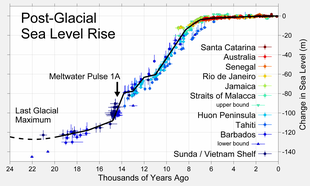Subboreal
The composite scientific term Subboreal, meaning "below the Boreal," is derived from the Latin sub (below, under) and the Greek Βορέας, from Boreas, the god of the North Wind.
[citation needed] In the Aegean, the beginning of the Subboreal was marked by a pronounced drought, centered around 5600 years BP.
[11] During the interval 5000 to 4000 years BP, drier conditions in southern Mesopotamia caused great demographic changes and the abandonment of settlings due to extreme aridity.
In the preceding interval lasting from 8200 till 5000 varve years (Holocene Climatic Optimum), the July temperatures were on average still 1 °C higher.
[8] In Northern Africa and in the Near East, the interval from 4700 to 4100 years BP had renewed and lasting dry conditions, as is indicated by lake level minima.
Between 4500 and 4100 years BP, monsoonal precipitations weakened,[13] a possible cause for the upheavals that led to the end of the Old Kingdom of Egypt.
That is less pronounced in Western Europe, but its typical mixed oak forest shows quite a fast decline in elm and linden.
[21] Another important event was the immigration of European beech (Fagus sylvatica) and hornbeam (Carpinus betulus) from their retreats on the Balkan and south of the Apennines.
The establishment of beech and hornbeam was accompanied by indicator plants for human settlements and agriculture like cereals and plantain (Plantago lanceolata), and hazel was receding.
In the North Sea region, the Flandrian transgression of the Atlantic was followed by a slight regression or standstill at the beginning of the Subboreal.


